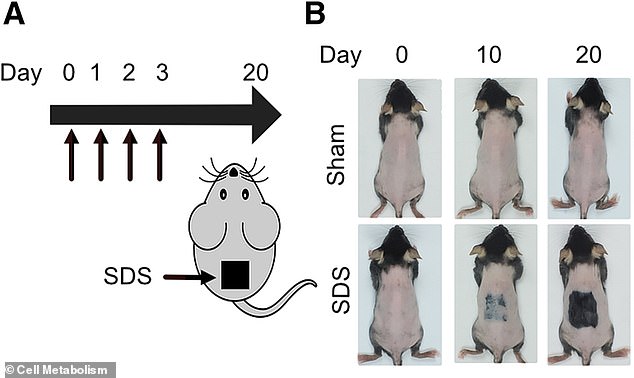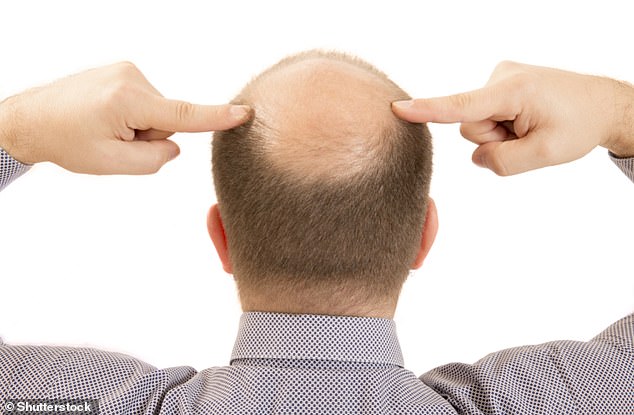Many balding men would do almost anything to have a full head of hair again.
Now, a simple cure for baldness could finally be around the corner – and it only takes 20 days to take effect.
Scientists at National Taiwan University have created a promising rub-on serum that restores hair growth in mice.
In their lab experiments, the serum stimulated fat cells in the skin that regenerated hair follicles.
According to the experts, the serum contains naturally derived fatty acids that don’t irritate the skin.
And it could soon be available for people in the form of over-the-counter skincare product.
Professor Sung-Jan Lin, study author at National Taiwan University, said he used an early version of the product on his legs.
‘I personally applied these fatty acids, dissolved in alcohol, on my thighs for three weeks and I found it promoted hair regrowth,’ he told New Scientist.

In mice, areas of skin treated with an irritant started to sprout new hair from follicles (the tiny pores on the surface of the skin)
Professor Lin and colleagues already knew irritation or injury to skin surface can promote excessive hair growth – a process known as hypertrichosis.
Although humans have lost dense hair coverage on most of their bodies during evolution, evidence suggests we preserve this to ‘important regenerative capacity’.
For their experiments, the team induced eczema on shaved mice of both sexes by applying an irritant called sodium dodecyl sulfate (SDS) to their backs.
Around 10 to 11 days later, treated areas of skin started to sprout new hair from follicles, which are just a fraction of a millimetre wide.
Conversely, hair didn’t regrow on the areas without eczema or on other shaved mice that weren’t treated with the chemical irritant during the period.
According to the researchers, the irritant causes immune cells to move into the layer of fat beneath a mouse’s skin.
This signals fat cells to release fatty acids that are absorbed by hair follicle stem cells, triggering hair growth.
‘These results demonstrate that skin injury not only induces tissue inflammation but also stimulates hair regeneration,’ the team say in their paper, published in Cell Metabolism.

According to the researchers, the irritant causes immune cells to move into the layer of fat beneath a mouse’s skin. This signals fat cells to release fatty acids that are absorbed by hair follicle stem cells, triggering hair growth
Next, the experts wanted to see the effect of fatty acids on skin without the use of any chemical irritant, so they created serums made of different fatty acids dissolved in alcohol, such as oleic acids and palmitoleic acids.
Promisingly, researchers found these to be effective in promoting hair regeneration when applied to skin without the irritant.
They have patented their serum and plan to test different dosages of the serum on people’s scalps before hopefully marketing it – although as yet it’s unclear when this would be and how much it would cost.
‘Oleic acids and palmitoleic acids are naturally derived fatty acids,’ Professor Lin told New Scientist.
‘They are not only rich in our adipose tissues, but also in many plant oils, so they can be safely used.’
Already, they’ve seen promising results when applying it to human hair follicles in the lab, as well as Lin’s thighs – and they don’t expect it to have any severe side effects.
They stress that the hair growth-promoting mechanism has not been scientifically validated yet in a range of human volunteers, which would be the next step.
The team conclude: ‘Supported by our experimental results, demonstrating hair growth activation upon topical application of monounsaturated fatty acids, their natural existence and established safety profile suggest considerable potential for treating hair loss conditions in the future.’

At least half of men over the age of 50 will lose some of their hair just through the ageing process (stock image)
Similar serums for hair loss are also in development, including the one at Schweitzer Biotech Company in Taiwan which shows shows promising results after just two months.
Meanwhile, researchers in Madrid have used stem cells, which have the potential to create new hair follicles by replicating younger ones.
In humans, the stem cell treatment would be administered to the scalp through an injection, but would require administration by a specialised healthcare professional.
Currently, there are various treatments for hair loss, including drug therapies, lasers and follicular transplantations, although they are not without limitations.
Chemical treatments such as minoxidil and finasteride are already commercially available, but these can cause nasty side effects ranging from depression to sexual dysfunction.
